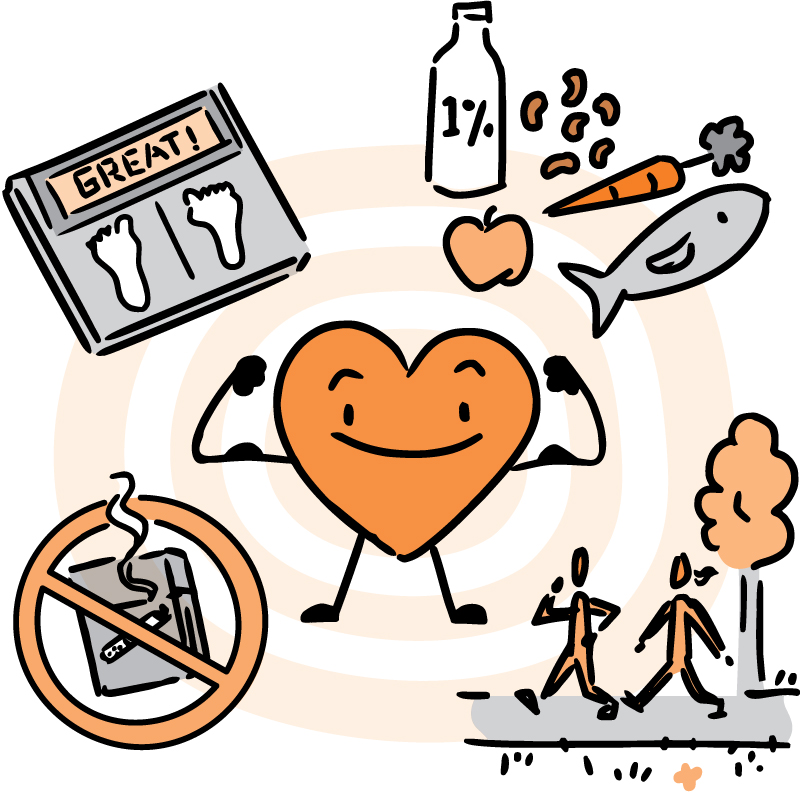Love Your Heart
Take Steps To Reduce Heart Risks

February is American Heart Month—a time to reflect on the sobering fact that heart disease remains the number one killer of both women and men in the United States. The good news is you have the power to protect and improve your heart health.
NIH and other government agencies have been working to advance our understanding of heart disease so that people can live longer, healthier lives. Research has found that you can lower your risk for heart disease simply by adopting sensible health habits.
To protect your heart, the first step is to learn your own personal risk factors for heart disease. Risk factors are conditions or habits that make you more likely to develop a disease. Risk factors can also increase the chances that an existing disease will get worse.
Certain risk factors—like getting older or having a family history of heart disease—can’t be changed. But you do have control over some important risk factors such as high blood cholesterol, high blood pressure, smoking, excess weight, diabetes and physical inactivity. Many people have more than one risk factor. To safeguard your heart, it’s best to lower or eliminate as many as you can because they tend to “gang up” and worsen each other’s effects.
A large NIH-supported study published last month underscores the importance of managing your risk factors. Scientists found that middle-aged adults with one or more elevated risk factors, such as high blood pressure, were much more likely to have a heart attack or other major heart-related event during their remaining lifetime than people with optimal levels of risk factors.
“For example, women with at least 2 major risk factors were 3 times as likely to die from The system of heart and vessels that circulates blood throughout the body. cardiovascular disease as women with none or 1 risk factor,” says Dr. Susan B. Shurin, acting director of NIH’s National Heart, Lung and Blood Institute. “You can and should make a difference in your heart health by understanding and addressing your personal risk.”
To tackle your heart risk factors, it helps to know your numbers. Ask your health care provider to measure your blood cholesterol and blood pressure. Then determine if your weight is in the healthy range.
The higher your cholesterol level, the greater your risk for heart disease or heart attack. High blood cholesterol itself doesn’t cause symptoms, so you can’t know if your cholesterol is too high unless you have it tested. Routine blood tests can show your overall cholesterol level and separate levels of LDL (“bad”) cholesterol, HDL (“good”) cholesterol and triglycerides. All of these blood measurements are linked to your heart health.
High blood pressure (hypertension) is another major risk factor for heart disease, as well as for stroke. High blood pressure is often called the “silent killer” because, like high cholesterol, it usually has no symptoms. Blood pressure is always reported as 2 numbers, and any numbers above 120/80 mmHg raise your risk of heart disease and stroke.
“Scientific evidence is strong that controlling high blood cholesterol and high blood pressure prevents cardiac events such as heart attacks,” says Dr. Michael Lauer, a heart disease specialist at NIH.
Your weight is another important number to know. To find out if you need to lose weight to reduce your risk of heart disease, you’ll need to calculate your body mass index (BMI, a ratio of weight to height). This NIH web page can help: www.nhlbisupport.com/bmi/bmicalc.htm. A BMI between 25 and 29.9 means that you’re overweight, while a BMI of 30 or higher means obesity.
Next, take out a tape measure. A waist measurement of more than 35 inches for women and 40 inches for men raises the risk of heart disease and other serious health conditions. Fortunately, even a small weight loss (between 5% and 10% of your current weight) can help lower your risk.
NIH has many tools available to help you aim for a healthy weight, including physical activity tips and a menu planner. To learn more, visit healthyweight.nhlbi.nih.gov.
A heart-healthy diet includes a variety of fruits, vegetables and whole grains, as well as lean meats, poultry, fish, beans and fat-free or low-fat dairy products. Try to avoid saturated fat, trans fat, cholesterol, sodium (salt) and added sugar.
NIH's Therapeutic Lifestyle Changes (TLC) and Dietary Approaches to Stop Hypertension (DASH) diets both promote healthy eating. U.S. News & World Report named TLC and DASH the top 2 overall diets for 2012.
Regular physical activity is another powerful way to reduce your risk of heart-related problems and enjoy a host of other health benefits. To make physical activity a pleasure rather than a chore, choose activities you enjoy. Take a brisk walk, play ball, lift light weights, dance or garden. Even taking the stairs instead of an elevator can make a difference.
“At least 2 and a half hours a week of moderate-intensity physical activity can lower your risk of heart disease, stroke, hypertension and diabetes—a winner on multiple counts,” says Dr. Diane Bild, a cardiovascular epidemiologist at NIH.
If you have diabetes, it’s important to keep your blood sugar, or glucose, under control. About two-thirds of people with diabetes die of heart or blood vessel disease. If you’re at risk for diabetes, modest changes in diet and level of physical activity can often prevent or delay its development.
If you happen to be a smoker, the best thing you can do for your heart is stop. People who smoke are up to 6 times more likely to suffer a heart attack than nonsmokers. The risk of heart attack increases with the number of cigarettes smoked each day.
The good news is that quitting smoking will immediately begin to reduce your risk, and the benefit in reduced risk will continue to increase over time. Just one year after you stop smoking, your risk will have dropped by more than half.
Beyond controlling your risk factors, you should be alert to certain symptoms and get checked by a doctor. Common signals that something‘s wrong with your heart include angina—pain in the chest, shoulders, arms, neck, jaw or back—as well as shortness of breath, irregular heartbeat or palpitations (arrhythmia) and fatigue.
Be aware that the symptoms of a heart attack can vary from person to person. If you’ve already had a heart attack, your symptoms may not be the same if you have another one.
Finally, don’t forget that you can influence your loved ones’ heart health by setting an example. Do you have children, grandchildren or other young people who look up to you? If you follow a heart-healthy lifestyle, it’s more likely that they will, too. Because heart disease begins in childhood, one of the best things you can do for those you love is to help children build strong bodies and healthy habits.
The bottom line is, it’s never too late to take steps to protect your heart. It’s also never too early. Start today to keep your heart strong. Talk to your doctor about your risk and to create an action plan. Love your heart.
NIH Office of Communications and Public Liaison
Building 31, Room 5B52
Bethesda, MD 20892-2094
nihnewsinhealth@od.nih.gov
Tel: 301-451-8224
Editor:
Harrison Wein, Ph.D.
Managing Editor:
Tianna Hicklin, Ph.D.
Illustrator:
Alan Defibaugh
Attention Editors: Reprint our articles and illustrations in your own publication. Our material is not copyrighted. Please acknowledge NIH News in Health as the source and send us a copy.
For more consumer health news and information, visit health.nih.gov.
For wellness toolkits, visit www.nih.gov/wellnesstoolkits.




